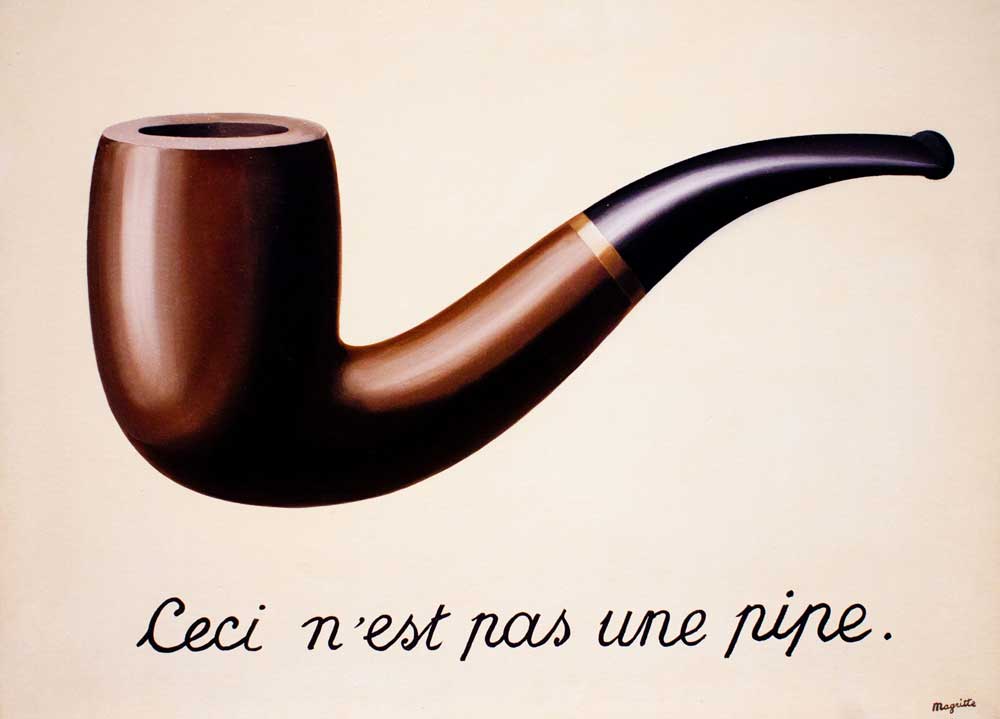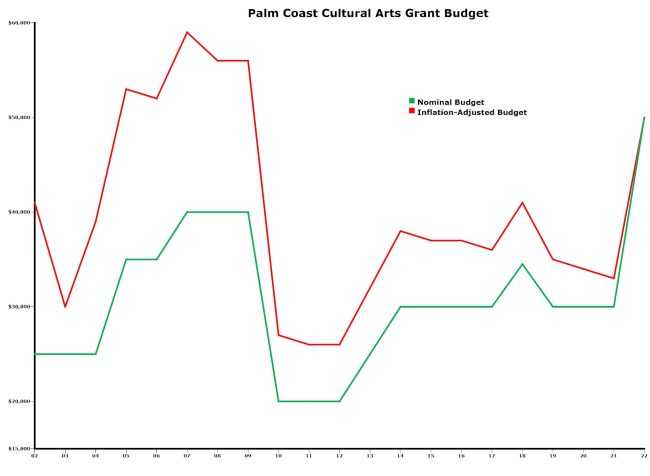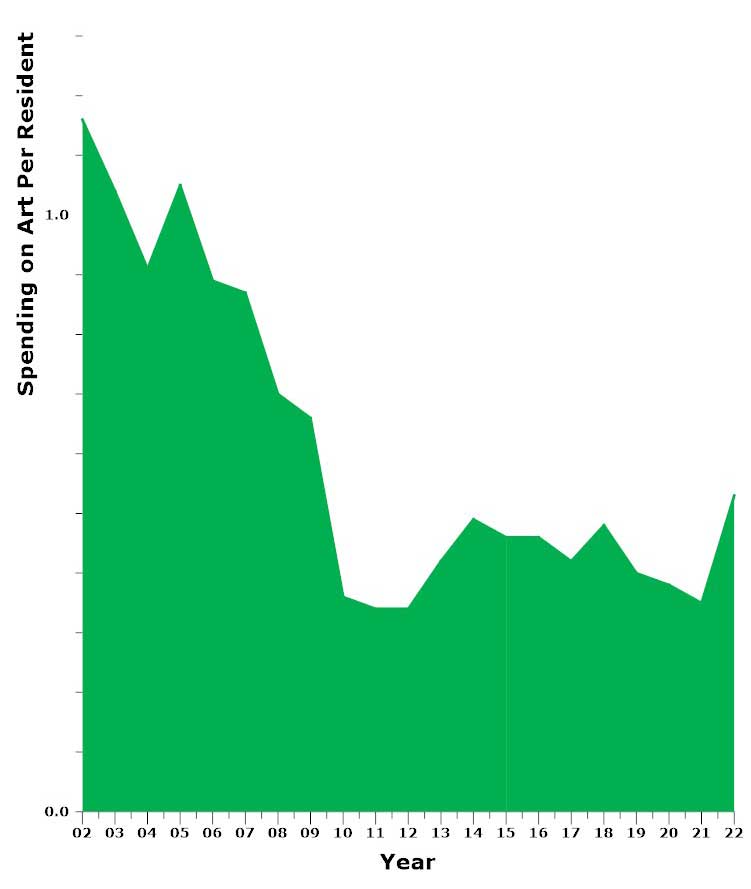
Palm Coast government will award $39,000 in cultural arts grants to 11 organizations to underwrite events between now and next summer, with $11,000 yet to be awarded.
This year’s budgeted amount of $50,000 for arts grants is the highest since the city began the program in 2002, and it is already the highest amount awarded. Between 2007 and 2009, the city budgeted $40,000 for the grants, but each of those three years it awarded between $24,000 and $32,000.
The city in the past was criticized, sometimes by its own council members–the late Bill Lewis especially–for being too stingy with its arts grants. “It’s a joke, really, when we talk about millions of dollars for many other things, and we’re not serious about doing something about arts,” he said 10 years ago, when the city awarded just $20,000 in grants. It had awarded the same amount the year before, when it spent $67,000 just to pave a road extension into the Indian Trails Sports Complex.
This year’s budgeted amount may seem like a big increase. In nominal, or current, dollars, it is: it’s a 51 percent increase over last year’s budgeted amount of $33,000. But in inflation-adjusted dollars, the city is budgeting less than it has in five previous years, and in per-resident spending on the arts, it is still spending less than it did in the first eight years of the program.
When adjusted for inflation, the city in those first eight years budgeted between $39,000 and $59,000 a year for the grants. Its per-resident spending, on an adjusted basis, was between 75 cents to $1.16, the last figure representing the amount of spending in the inaugural year of the grants. At the time, Palm Coast had a population of just 35,000. It now has an estimated population of around 95,000. Even with this year’s big jump in budgeted dollars, the per-resident spending is just 53 cents. It is nevertheless the highest amount in 12 years:
The city budgeted $25,000 in the program’s first year (not including an additional $3,000 for the Palm Coast Historical Society). “After all, it is taxpayer money and we want to help as many organizations as we can,” then-Council member Ralph Carter–for whom the park in the R Section is named–said. Seven organizations won grants between $1,500 and $4,500, among them some that have receiving grants in most years since, like the African American Society of Palm Coast and the Choral Arts Society. Others have disappeared, like the Flagler Symphonic Society, the Millennium Art Guild of Palm Coast and the Little Theatre of Palm Coast.
Palm Coast was in the midst of a boom, its population climbing by many thousands each year. The budgeted amounts rose apace, to their highest level in 2007, when, in inflation-adjusted dollars, the amount reached $59,000. But that year the city got a new manager who was not as inclined to keep those dollars flowing. The budgeted amount fell to $27,000 and $26,000, even after adjusting for inflation, prompting Lewis to grouse. They have never risen back to their former levels, only coming a bit closer this year:

The city is supporting the arts in less direct but substantial ways. It is leasing the 13 acres at Town center Boulevard and Central Avenue to the Palm Coast Arts foundation for the sum of $1 a year, enabling the foundation to hold music and theater productions there, and its weekly arts bazaar, among other events. The city built the bathrooms at the site, at the city’s expense. The city is also partnering with the foundation for the first Palm Coast Arts festival on Oct., 22 in nearby Central Park, where at least 30 artists will showcase their work.
Two years ago the city designated Town center as arts district in hopes of spurring more activity. It commissioned a study, the first part of which is completed, to analyze where and when to build a cultural center–essentially, a community center for the arts. Palm Coast Mayor David Alfin said the city is prepared to donate land for that cultural; center, but construction would depend on a partnership with private concerns. “Those grants are not barely even the tip of the iceberg,” Alfin said, noting how the city has played a key role in creating United We Art, a coalition of local arts groups hoping to turn the arts into a mainstay of the region’s attractions. (United We Art is a co-sponsor of the Fall Arts Festival.)
Lauren Johnston, the assistant city manager who’s overseeing the arts initiative, acknowledges that the cultural center would be costly–in the $30 to $50 million range–and would be a distant ambition. “But what we do have is land and so can we work with university partners, or is there any type of other stakeholders in the community, any corporate sponsorships that we could look at,” Johnston said. “So we are looking at trying to make it a real thing, but just also being mindful of our financial impacts.”
In the immediate, the city’s most direct impact on the arts is through those cultural grants, which can have a disproportionate impact on the cultural landscape.
James Hirst, the city’s Parks and Recreations director, presented this year’s first round of grants to the City Council on Tuesday. This year the grants have two tiers. Grants in the first tier are expected to draw on spectators and participants in the county and beyond–people who would stay in local hotels. The tier reflects the city’s modeling arts grants on its tourist-based approach to attracting sports and other events to the city.
Three organizations won such grants, all at $5,000: The African-American Cultural Society, the Flagler Auditorium and the Palm Coast Music Festival. (One of the applicants had incomplete information and was to use funds for “non-allowable expenses,” Hirst said.) The second-tier grants are for $3,000 each. Yes, the Choral Society is on the list again. (See the full list here.)
Under Hirst’s guidance, even those who failed in the first round will have a chance to land a grant in a second round, with those $11,000 still on the table. “We will guide them, kind of give them the right information, work through them so they will be ready for round two and then hopefully we can give some of this grant money to them as well,” he said. In that regard, the city is far more aggressive in helping arts groups become aware of the grants–and in shepherding them toward an award. In the past, the city took a harder line: groups either qualified by meeting all the city’s demands or were out of luck.
As always, the grants do not entail up-front money. The organizations must provide receipts for their expenses, such as proof that they spent 10 percent of the grant on marketing, that the money was spent in direct support of the Palm Coast-based event, and so on, before they can be reimbursed.
“So not only are we trying to give the groups money that they can do their productions with, but we’re also trying to enhance the experience and make people more aware,” Johnston said. “That advisory group is helping us with ideas of what can we put into our budget that would be fruitful, because they’re really the experts, right? So we really value the partnership that PCAF brings to the table, and CRT.” PCAF is the Palm Coast Arts Foundation. CRT is City Repertory Theatre.
A financial breakdown of the city’s Cultural Arts Grant program since its inception appears below.
![]()
Palm Coast Arts Funding, 2002-2022
| Year | Budgeted (nominal) | Inflation-adjusted | Population | Per Resident |
| 2002 | $25,000 | $41,000 | 35,443 | $1.16 |
| 2003 | $25,000 | $40,000 | 38,348 | $1.04 |
| 2004 | $25,000 | $39,000 | 42,850 | $0.91 |
| 2005 | $35,000 | $53,000 | 50,484 | $1.05 |
| 2006 | $35,000 | $52,000 | 58,216 | $0.89 |
| 2007 | $40,000* | $59,000 | 67,832 | $0.87 |
| 2008 | $40,000** | $56,000 | 70,376 | $0.79 |
| 2009 | $40,000*** | $56,000 | 74,590 | $0.75 |
| 2010 | $20,000 | $27,000 | 75,180 | $0.36 |
| 2011 | $20,000 | $26,000 | 75,617 | $0.34 |
| 2012 | $20,000 | $26,000 | 76,450 | $0.34 |
| 2013 | $25,000 | $32,000 | 77.068 | $0.42 |
| 2014 | $30,000 | $38,000 | 78,046 | $0.49 |
| 2015 | $30,000 | $37,000 | 79,821 | $0.46 |
| 2016 | $30,000 | $37,000 | 81,184 | $0.46 |
| 2017 | $30,000 | $36,000 | 82,760 | $0.43 |
| 2018 | $34,500 | $41,000 | 84,575 | $0.48 |
| 2019 | $30,000 | $35,000 | 86,768 | $0.40 |
| 2020 | $30,000 | $34,000 | 89,437 | $0.38 |
| 2021 | $30,000 | $33,000 | 92,866 | $0.35 |
| 2022 | $50,000 | $50,000 | 95,000 | $0.53 |






























Dennis C Rathsam says
With the current estate of the economy, where some families struggle to put FOOD… on the table! U should be happy what U got instead of complaining! Out of touch with reality!